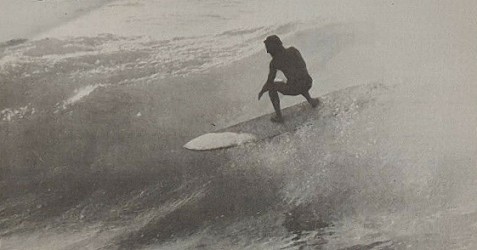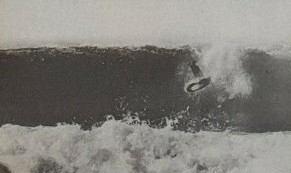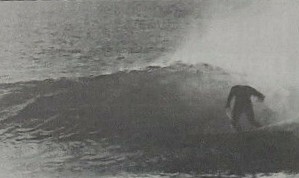surfresearch.com.au
 |
surfresearch.com.au
bob
mctavish : pods for primates #2
|
Bob
McTavish : Pods for Primates - A
Personal history of Surfboard Design, Part 2.
Tracks
May 1973
Reprinted in The
Best
of Tracks 1973
Introduction
Bob McTavish's
ground breaking and inspirational historical overview of
Australian surfboard design from the early solid timber boards
until the current designs, circa 1972, is a major influence on
the creation of this web site.
The sub-title,
possibly added by the editor, is most probably a reference to
Kenneth Clarke's outstanding 1969 BBC television documentary and
subsequent book, Civilisation - A Personal View.
Despite the poor
editing of the article, the selection of images and the design
layout are to Tracks usual high standard.
The editor's notes in brackets note spelling errors, some
historical clarification and associated links to relevant
material.
Of course, see Part 1.
Also see extra images.
Page 20
Pods for Primates
A PERSONAL HISTORY OF SURFBOARD DESIGN Part 2.
By Bob
McTavish
Since boards went short in 1967, there have been many, many
good surfers, many good designers and stacks of good surfing.
You can fill a
library with tales of this era.
This record is
only a skeleton and many good people won't get a mention
because of space, but it gives an approximate trail of where
we are today.
We could
trace the change from the old trimming boards to the new
short carving boards from two different lines.
Firstly, in
America they smoothed out their lines before they went
short.
Dick Brewer
working with Bing (Surfboards) made his pipeline ("Pipeliner")
series which were beautiful pin-tails, this was early
67; by the end of the year he had made a couple of 9ft
versions of these pin-tails.
Here in
Australia George Greenough had been coming to our shores for
several years riding belly-boards (sic, kneeboards - the
Greenough Spoon) that carved and
extracted so much speed and power from the wave, without
having to use a turning point and separate trimming point,
they were both combined together.
It became
fairly obvious to surfers that had seen him that this was
the direction to go.
Nat in Easter
(April?) of 67 (1967) made a 9' 7" board with 6'
(or 6'' ?) of V in the bottom which was based on a
Greenough design.
This thing
turned like crazy and carved incredible arcs. (seeHot Generation,
Part 5)
Later on in
the year Kevin Platt and myself at Keyo's (Surfboards)
started making V bottoms.
First they
were 9', then 8' 6" then 8', then down to 7' 1 0".
The first
reaction of stepping on these boards was the incredible power
and speed and bashing ability in a turn, in fact the first
time you rode them, they usually flew out from underneath your
feet.
At the same
time Midget's(Farrelly) shop at Palm Beach was running stiff
competition with us at Keyo's.
As we'd cut 2" off, Midget would cut 4" off,
then vice versa.
 |
Graphic by Geoff Watson,
Best of Tracks, page
122.
Not 100%
accurate. |
Page 21
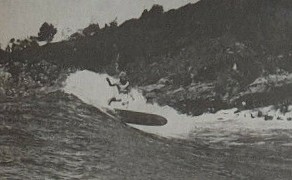
Midget
|
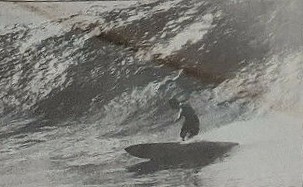
Nat
|
Greenough
|
McTavish
|
We took our
boards to Hawaii in late 67, they were, just large versions of
V bottom stubbies we were riding in the shorebreaks of
Australia and they were pretty miserable failures except for
Nat's board which was more of an arrow planshape and Ted
Spencer's little double end sausage ('Little Red ')
which went well in small surf.
(see Hot Generation, Part 6)
Midget took
to Brewer's ideas and came back making pin-tails.
Up on (sic)
the San Juan (Surfboards) factory, in Byron Bay we
started making 7' 8" then 7'4", then 7', they were getting
shorter and shorter, lighter and lighter.
Finally we
sacrificed one layer of (fibre) glass and broke the
10lb barrier.
The same
things were happening in shops everywhere.
Down south
Wayne Lynch was making 7' 6" very full
pin-tails with a V bottom in the middle which gave him
a tremendous looseness and the width of the board gave a lot
of speed and power and he could direct this speed onto
vertical work, he was punching up through the width (?- lip?) heading
up vertical and coming upsidedown for a brief second,
he was really pushing it a long in this direction. (see
EvolutionPart 1)
Late in
1968 Nat (Young) was making his skis
(Ski by Dewey Weber Sufboards, USA, see
Evolution , Part 5?)
which were soft railed, for in 69 in Hawaii it was Joey
Cabell, Brian Dobson ( ? Ryan Dotson) and Dick
Brewer who were the top designers, making speed shapes with
narrower noses, longer lines and the rails were getting
lower and lower.
By then I
was riding approximately an 8' board in 12' Sunset surf. (seeSurf
International, Vol 1 No. 6 1970? pp 8 to 11.)
Meanwhile in
Australia we were going the opposite direction, the boards
were getting short, the rails softer and softer, this is
when the Greenough hulls took on with very high. rails in
the front turning down at the tail.
This is
when Ted Spencer was making white kites (White Kites) at Shanes (Shane Surfboards) with a soft rail
all the way thru.
David
Treloar was making soft rail foils at Nippers (Nipper
Williams Surfboards).
These boards
you could really bank them over on the rail but when you got
them over they did nothing.
There was
the occasional exception, Gary Keyes made a board at
Angourie that had almost down rails and about 1/4" of shape
up from the bottom, much like a modern rail.
This board
was very sleek, fast, smooth turning and even had a little
bit of side slip release, but it was controllable.
Then (at)
the end of 1969 Russell Hughes came back from America and
brought with him a Dick Brewer board with down rails from
nose to tail.
It wasn't
the first; they had been around for a couple of years but
only cranks and crackpots were riding them.
But now they
had become the standard equipment in Hawaii.
Russell also
brought back a Lopez board with down soft rails.
This really
blew the Australian designers apart because they had been
going in a soft rail direction for some time.
To suddenly
step on a down rail gave you so much speed that you could
see a section looming way ahead and you were past it before
you knew what to do with.
It certainly
took a lot of adjusting.
Their
application in Australia came first in the side-slipper.
It was
short with down soft rails and a small fin, which
prohibited hard banking but allowed for beautiful side slip
release.
It was
certainly amazing to see a graceful surfer release his fin
and travel side ways in a full drift down the wall.
This design
took on with quite a large group of surfers, amongst them
Midget, up and coming Terry Fitzgerald, Col Smith, whereas
Nat and Ted Spencer investigated another direction (.)
(They)
they went shorter and shorter, broke the 6 foot barrier, put
on big fins and still using fairly soft rails but down they
were riding micro-stubs.
Meanwhile
Geoff McCoy started his shop and started to promote this
style of board in the Sydney surf.
It was quite
successful, had its fair share of speed overturn, if the
waves were short and powerful it did quite well.
But they had
very little reserve of speed, they couldn't carry a super
long arc.
When the
World Contest happened in Australia (Johanna Beach), at the end of
1970 it really impressed most people to see all the American
surfers specialising in their own style of board.
Some were
long, some short, some side slippers, some were carvers, but
its obvious now the trend was towards speed, the rails were
low, the plan shapes were drawn and since then in Australia
this has been a standard design which has survived thru all
the fads and changes.
Twin fins (1) hit not long after
this (Summer 1970-1).
They took on
quite well but they weren't all good designs.
They are a
hot dog board, they allow you to turn incredibly well on
mushie (sic) waves.
Its even a
different kind of turn, like a ball bearing turn or
skateboard turn.
You can
really push your momentum around and thru a tight little
arc.
But as the
desire for speed came on stronger, the twin fin plan shapes
went narrower and rakier and this defeated their purpose.
Nat was
making some beautiful boards at this time, he came back from
the Islands with some beautiful Cabell shapes, the rails
were large boxy, they had a fair bit of bottom curve tail
lift which was a new thing at the time, a sensible thing. (see# 38)
In 1972,
the twin fins had gone, the tri
fins made a brief appearance but it didn't hold for
long and it was basically seat (sic?) speed
shapes.
A few
different freakie things came in, in 1972 there was
extravagance in tail lifts, there were super large soft
rails almost like surf mattress rails, there were tucked
under rails, radical box rails, then we saw the appearance
of the keel. (see# 336)
This seemed
good potential direction, they are yet to prove themselves.
And this
year 1973, we find it still the same thing, it's speed
shapes, it's down rails, it"s the soft bottom line, smooth
nose entry.
We have lots
of designers all tampering with relatively minor aspects of
the same design.
We find
Midget making hard tails and some beautiful pin-tails.
Geoff McCoy is making nice speed
lines, Bill Cillia, Tim Rodgers, Kevin Platt, John Blanch, Bob Cooper, Pat Morgan, there are many
many more.
There seems
to be a current of unrest running thru the various surfing
communities.
Some people
still want more speed and why not!
Some people
want more banking abiliy at high speed, for instance
whatever happened to nose on the water turns that we could
do in 1968 and we never did get upsidedown for very long,
did we.
The
Greenough bowlers (Hulls) at
Angourie did it but what about everyone else, and everywhere
else.
What about
out thru the back, a board going at todays speed should be
able to leave the wave entirely and glide on the flat water
behind the wave for a while and then back in over the lip
and into it for more speed.
Maybe there
is a radical new design needed, maybe we have touched on it
over the past 6 years, maybe it was chines, maybe it was
tucked under tails (rails?), maybe it was full length V
bottoms, maybe its in the fin.
While we are
waiting to see what comes up, a lot of surfers are finding
themselves going towards smoother, more artistic surfing.
They are
using the speed and the obvious sensitivity and control of
the down rails to put themselves in very tight positions and
doing it gracefully and beautifully.
Even if the
change doesn't come up in the near future we are certainly
going to see a lot of progress in this direction, smooth,
fast, flowing beauty.
One thing
in retrospect shows out really clearly.
Since 1967
we have Iearnt to ride powerful waves.
In 1966-67
the ultimate wave was Noosa, it was Crescent, perhaps small
Angourie.
It was a
long clean wall.
Now we're
after juice, whether its tight, whether its long,
high, short, thick, as long as it has some juice we are into
it.
Are we
neglecting the long small waves of Noosa, Byron Bay and
Crescent, maybe someone should be back on an updated 9 foot
board, perhaps a 10 lb version of it, doing all the old
things we used to admire so much, the speed from trimming,
the stalling, pivoty turns, the graceful screaming nose
rides, the head dips, the fun.
At least now
our eyes are open to Australia's big wave potential.
The waves we
used to watch break but didn't consider riding them we are now
hungry for.
There is lots
of juice pumping in around our coast, there's still lots of
breaks, where the crowds don't get and where our boards allow
us to go, to use and really get into it, but it can go a lot
further.
Extra Images.
Page 4
There
are 129,631 frames in Albert Falzon and George
Greenough's new film and this is one of them.
Premier December
1973.
Nat Young, Pat Morgan Keel Fin, California, 1973.
|
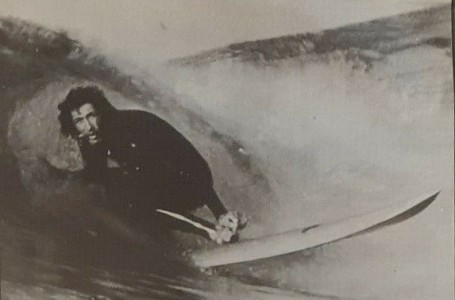
|
Some other photographs:
 |
Bob
McTavish
Honolua Bay, Maui, 1967.
Photograph: John Witzig
Jarratt
:
Hakman,
page 62.
George
Greenough
North coast free-fall 1965.
Photograph
by Tanya Binning.
First published in
Surfing World Number 196,
this cropped version from
Margan
and
Finney, page 310
|

The most outstanding photograph
of committed high performance surfing
up to this date, this level of performance was probably
not achieved
by stand up surfers for another ten years.
|
 |
Tracks
Number 32
May 1973
The Best of Tracks
1973 |
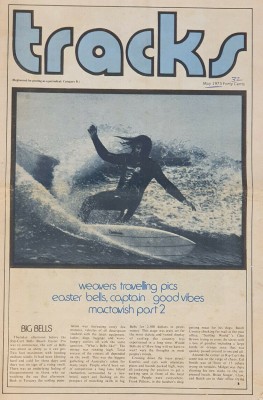 |

surfresearch.com.au
Geoff Cater (1999-2020) : Bob McTavish :
Pods for Primates, 1973.
http://www.surfresearch.com.au/1972_McT_Pods2_Tracks_April.html

